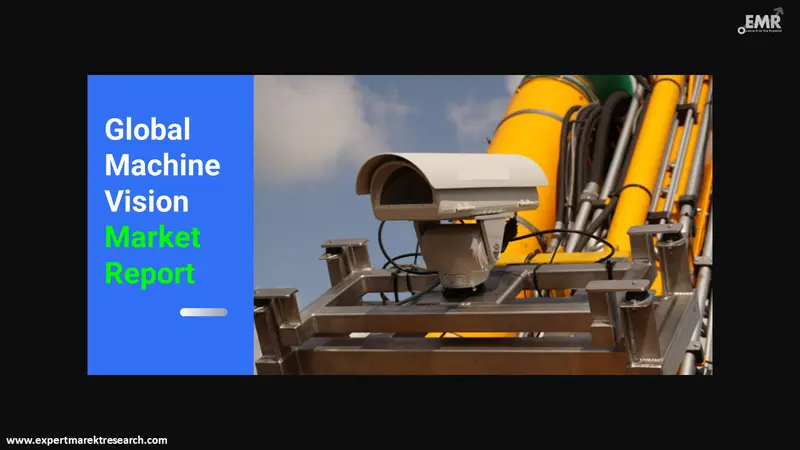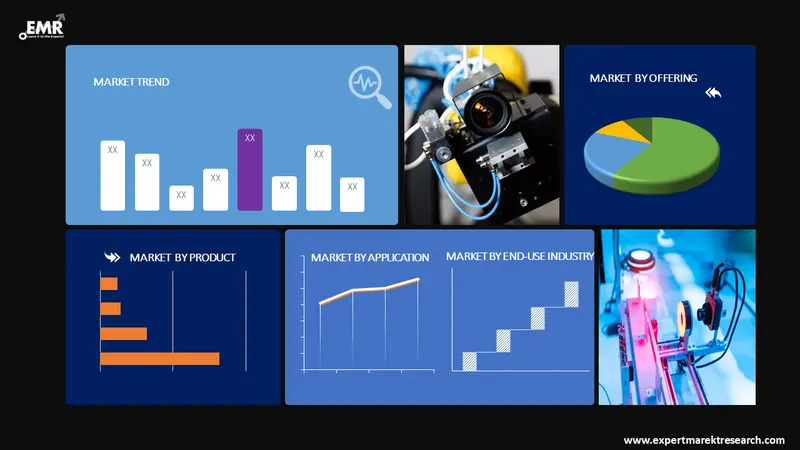
Consumer Insights
Uncover trends and behaviors shaping consumer choices today
Procurement Insights
Optimize your sourcing strategy with key market data
Industry Stats
Stay ahead with the latest trends and market analysis.
The global machine vision market size reached a value of around USD 11.74 Billion in 2025. The market is projected to grow at a CAGR of 7.90% between 2026 and 2035, reaching a value of nearly USD 25.11 Billion by 2035.
Base Year
Historical Period
Forecast Period
Compound Annual Growth Rate
7.9%
Value in USD Billion
2026-2035
*this image is indicative*
| Global Machine Vision Market Report Summary | Description | Value |
| Base Year | USD Billion | 2025 |
| Historical Period | USD Billion | 2019-2025 |
| Forecast Period | USD Billion | 2026-2035 |
| Market Size 2025 | USD Billion | 11.74 |
| Market Size 2035 | USD Billion | 25.11 |
| CAGR 2019-2025 | Percentage | XX% |
| CAGR 2026-2035 | Percentage | 7.90% |
| CAGR 2026-2035 - Market by Region | Asia Pacific | 8.8% |
| CAGR 2026-2035 - Market by Country | China | 8.7% |
| CAGR 2026-2035 - Market by Country | USA | 8.5% |
| CAGR 2026-2035 - Market by Offering | Software | 8.6% |
| CAGR 2026-2035 - Market by Product | Smart Camera Based | 8.3% |
| Market Share by Country 2025 | Germany | 4.4% |
Machine vision is a technology that enables industrial equipment and computers to see and make rapid decisions based on the data. This technology is used for various applications, including visual inspection, positioning and measuring parts, and defect detection. It is also capable of identifying, sorting, and tracking products.

Read more about this report - REQUEST FREE SAMPLE COPY IN PDF
One of the major trends fuelling the machine vision market growth includes the adoption and implementation of advanced technologies following innovations like Industry 4.0 and the Industrial Internet of things (IIoT). The digital transformation of various industrial sectors, coupled with the growing integration of advanced technologies such as analytics, the internet of things (IoT), machine learning, cloud computing, and AI, is also driving the adoption of machine vision.
The increasing focus on the development of smart factories equipped with computer vision-enabled equipment, embedded software, advanced sensors, and robotics, to drive real-time decision-making, productivity, and automation is bolstering the market for machine vision.
However, this advanced equipment comes with a high initial cost and requires investment in frequent maintenance activities, which can hamper the market growth.

Read more about this report - REQUEST FREE SAMPLE COPY IN PDF
The EMR’s report titled “Machine Vision Market Report and Forecast 2026-2035" offers a detailed analysis of the market based on the following segments:
Market Breakup by Offering
Market Breakup by Product
Market Breakup by Application
Market Breakup by End-Use Industry
Market Breakup by Region
| CAGR 2026-2035 - Market by | Country |
| China | 8.7% |
| USA | 8.5% |
| UK | 8.0% |
| Australia | 7.6% |
| Mexico | 7.4% |
| Canada | XX% |
| Germany | 7.4% |
| France | XX% |
| Italy | XX% |
| Japan | XX% |
| India | XX% |
| Brazil | XX% |
| Saudi Arabia | 7.3% |
PC-based machine vision systems account for a significant machine vision market share as they offer enhanced flexibility, enable the use of third-party software packages, and provide high speed and power. Such systems also can efficiently handle complex applications at a high speed while providing a framework for real-time calling of modular software elements.
Meanwhile, smart camera-based machine vision systems are expected to register a high growth rate during the forecast period due to the growing implementation of cameras for 3D sensing and imaging. Smart camera-based systems are also applied for the identification of tags and labels while reducing human intervention and the possibility of errors.
The automotive sector holds one of the largest market shares in the global machine vision market. The growth of the market can be attributed to the extensive deployment of machine vision for inspection purposes, assembly verification, error proofing, and final inspection. Additionally, machine vision equipment are deployed in the automobile sector for robotic steering, testing automation, and dimensional measuring, which is further propelling the growth of the market segment.
The Asia Pacific accounts for a major portion of the market for machine vision owing to the rapidly developing industrial sectors such as automotive, packaging, pharmaceutical, and other industrial applications.
As the region is undergoing rapid industrialisation, the increasing investment in various industrial sectors for the implementation of advanced technologies is anticipated to provide expansion opportunities to the machine vision market. The robustly growing electronics, semiconductors, and automotive sectors in China, India, South Korea, and Japan is also providing lucrative growth opportunities to the market for machine vision.
The comprehensive EMR report provides an in-depth assessment of the market based on Porter's five forces model along with giving a SWOT analysis. The report gives a detailed analysis of the following key players in the global machine vision market, covering their competitive landscape and the latest developments like mergers, acquisitions, investments, and expansion plans.
Allied Vision Technologies GmbH is an appliance, electrical, and electronics manufacturing company based in Germany. Since 1989, the company has pursued the development of state-of-the-art camera technology and image-capturing solutions. Its technologies are applied in various fields such as medical and scientific imaging, traffic monitoring, and industrial inspection, among other applications. It specialises in various fields including machine vision, image processing, medical imaging, industrial inspection, and embedded vision, among others.
Omron Corporation is a Japan-based electronics company and a global leader in the field of industrial automation. The company was established in 1933 and has since developed its business expertise in various fields, including control equipment, social systems, electronic components, and healthcare. The company’s product portfolio is comprised of a wide spectrum of products, including switches, safety components, relays, motion drivers, and sensors such as machine vision sensors.
Basler AG, founded in 1988, is based in Ahrensburg, Germany. It is one of the leading manufacturers of advanced imaging components for computer vision. It has developed multiple products such as computer vision software, cameras, frame grabbers, PC Cards, and embedded vision portfolios, among other products. Its products are utilised in a wide array of end-use sectors such as factory automation, traffic management, medical, robotics, logistics, and retail, among others.
*Please note that this is only a partial list; the complete list of key players is available in the full report. Additionally, the list of key players can be customized to better suit your needs.*
Other market players include Cognex Corporation, Keyence Corporation, National Instruments Corporation, Sick AG, Atlas Copco, Tordivel AS, and Teledyne DALSA, among others.




*While we strive to always give you current and accurate information, the numbers depicted on the website are indicative and may differ from the actual numbers in the main report. At Expert Market Research, we aim to bring you the latest insights and trends in the market. Using our analyses and forecasts, stakeholders can understand the market dynamics, navigate challenges, and capitalize on opportunities to make data-driven strategic decisions.*
Get in touch with us for a customized solution tailored to your unique requirements and save upto 35%!
In 2025, the global market for machine vision reached a size of nearly USD 11.74 Billion.
The market is assessed to grow at a CAGR of 7.90% during the period 2026-2035.
The market is projected to reach a value of around USD 25.11 Billion in 2035.
The growing implementation of smart cameras and sensors in different industrial sectors, increasing automation and technological advancements, and the increasing proficiency of machine vision technology are the major drivers of the market.
The increasing adoption and implementation of industry 4.0, the robustly growing automotive sector, and the rising development of smart factories are the key trends driving the market growth.
The major regions in the machine vision market include North America, Europe, the Asia Pacific, Latin America, and the Middle East and Africa.
The various offerings of machine vision considered in the market report include hardware, software, and services.
The major products considered in the market report include PC based and smart camera based.
The different applications of machine vision include assurance and inspection, positioning and guidance, measurement, and identification.
The significant end-use industries of machine vision include automotive, pharmaceuticals and chemicals, electronics and semiconductors, pulp and paper, printing and labelling, food and beverage, glass and metals, and postal and logistics, among others.
The key players in the market include National Instruments Corporation, Allied Vision Technologies GmbH, Keyence Corporation, Cognex Corporation, Omron Corporation, Teledyne DALSA, Atlas Copco, Tordivel AS, Basler AG, Sick AG, Others.
Explore our key highlights of the report and gain a concise overview of key findings, trends, and actionable insights that will empower your strategic decisions.
| REPORT FEATURES | DETAILS |
| Base Year | 2025 |
| Historical Period | 2019-2025 |
| Forecast Period | 2026-2035 |
| Scope of the Report |
Historical and Forecast Trends, Industry Drivers and Constraints, Historical and Forecast Market Analysis by Segment:
|
| Breakup by Offering |
|
| Breakup by Product |
|
| Breakup by Application |
|
| Breakup by End-Use Industry |
|
| Breakup by Region |
|
| Market Dynamics |
|
| Competitive Landscape |
|
| Companies Covered |
|
Datasheet
One User
USD 2,499
USD 2,249
tax inclusive*
Single User License
One User
USD 3,999
USD 3,599
tax inclusive*
Five User License
Five User
USD 4,999
USD 4,249
tax inclusive*
Corporate License
Unlimited Users
USD 5,999
USD 5,099
tax inclusive*
*Please note that the prices mentioned below are starting prices for each bundle type. Kindly contact our team for further details.*
Flash Bundle
Small Business Bundle
Growth Bundle
Enterprise Bundle
*Please note that the prices mentioned below are starting prices for each bundle type. Kindly contact our team for further details.*
Flash Bundle
Number of Reports: 3
20%
tax inclusive*
Small Business Bundle
Number of Reports: 5
25%
tax inclusive*
Growth Bundle
Number of Reports: 8
30%
tax inclusive*
Enterprise Bundle
Number of Reports: 10
35%
tax inclusive*
How To Order

Select License Type
Choose the right license for your needs and access rights.

Click on ‘Buy Now’
Add the report to your cart with one click and proceed to register.

Select Mode of Payment
Choose a payment option for a secure checkout. You will be redirected accordingly.
Gain insights to stay ahead and seize opportunities.

Get insights & trends for a competitive edge.

Track prices with detailed trend reports.

Analyse trade data for supply chain insights.

Leverage cost reports for smart savings

Enhance supply chain with partnerships.

Connect For More Information
Our expert team of analysts will offer full support and resolve any queries regarding the report, before and after the purchase.
Our expert team of analysts will offer full support and resolve any queries regarding the report, before and after the purchase.
We employ meticulous research methods, blending advanced analytics and expert insights to deliver accurate, actionable industry intelligence, staying ahead of competitors.
Our skilled analysts offer unparalleled competitive advantage with detailed insights on current and emerging markets, ensuring your strategic edge.
We offer an in-depth yet simplified presentation of industry insights and analysis to meet your specific requirements effectively.
Share